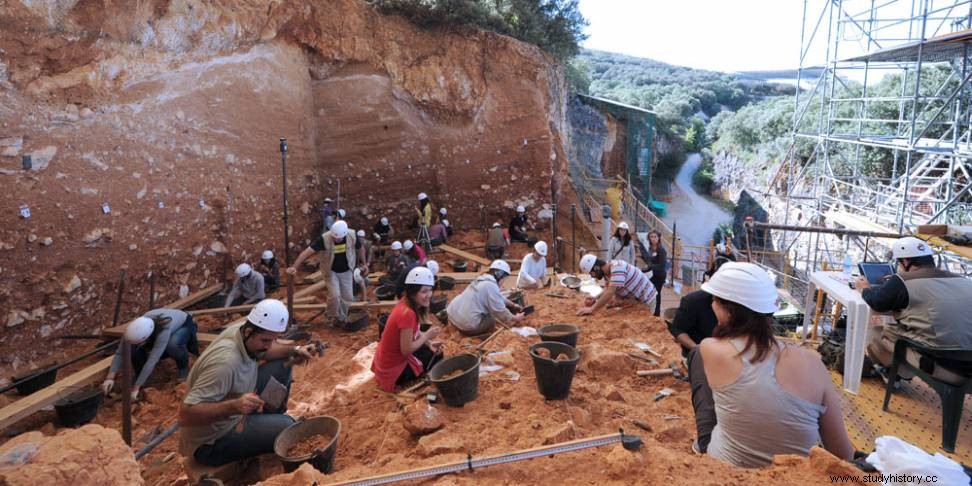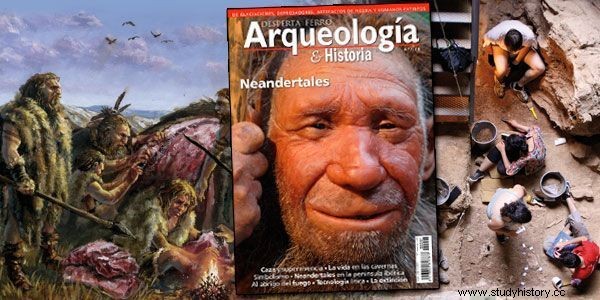
Last Thursday, June 16, the excavations began at the Sierra de Atapuerca sites , directed by Juan Luis Arsuaga, José María Bermúdez de Castro and Eudald Carbonell . In June around 75 people will excavate in the Sima del Elefante, Galería, Gran Dolina sites. and Mirador Cave . In July, the rest of the Atapuerca Excavation Team will arrive, adding some 280 people in total, and will excavate, in addition to the aforementioned sites, those of Cueva Mayor (Portalón, Sima de los Huesos and Galería de las Estatuas) and in the open-air settlement of Fuente Mudarra. In July, the sediment washing work will also begin on the banks of the Arlanzón River.
Most of the people who excavate in the Sierra de Atapuerca belong to different research centers of the Atapuerca Project:University of Burgos (UBU), National Research Center on Human Evolution de Burgos (CENIEH), Institute of Human Paleoecology and Social Evolution (IPHES – Tarragona), Center for Human Evolution and Behavior (Complutense University of Madrid – ISCIII) and University of Zaragoza (UNIZAR). There are also researchers from other universities and national and international research centers.
The Atapuerca Foundation, as a complement to the funding that the Junta de Castilla y León allocates to the excavations, will coordinate the operation of the campaign with organizational, administrative, economic, logistical support, maintenance, communication and organization of events.
The characteristics of the different sites that will be excavated this campaign and the objectives set for each of them are detailed below.
- Sima del Elefante
Located in the Trench of the Railway, human fossils over 1.2 million years old have been discovered at this site. It is intended to completely excavate level TE9c, which will allow the excavation of level TE9d in its entirety, which began to be intervened during the 2014 campaign and is located below TE9c. The aim is to locate the base of the Sima del Elefante cavity. According to topographical data, it is located at a depth of one meter from the surface of the borehole that was carried out last year. Finally, the drilling carried out in the southern area of the landfill will continue, specifically in the sediments that correspond to level TE7. Until now, this is the oldest fossil level in the entire Sierra de Atapuerca.
- Gallery
The Galería site is also located in the Trench of the Railway, about 50 meters from Gran Dolina. It covers a wide chronological range, between 500 and 250 thousand years. In this
campaign work will continue on the GIIIa subunit, dated between 220 and 280 thousand years. The archaeological levels, which during the ancient interventions provided a greater number of faunal remains and lithic tools than the entire Unit GIII, will be extensively excavated. In addition, the stratigraphic review of the site will continue.
- Gran Dolina
It is one of the best-known sites in the Trench of the Railway, in which the species Homo antecessor was discovered . Excavation will continue at two different levels:level TD10, about 400,000 years old, and level TD4, between 1,000,000 and 900,000 years old.
TD10
It is intended to close the preliminary interpretation of TD10.3 and, if possible, start to delve into the last remaining layer of TD10 (TD10.4) to finish explore the Acheulean world of Atapuerca.
TD4
An attempt will be made to expand the collections from ancient deposits, both lithic and faunal. In the same way, priority will be given to geochronological aspects that can help refine the chronology of the deposit and the configuration of the cave in that period.
- Mirador Cave
It is located at the southern end of the Sierra de Atapuerca, dominating the Arlanzón river valley. In this campaign, sectors 100 and 200 will continue to be excavated. From sector 100, level 105, from the Bronze Age, will be excavated and Chalcolithic levels will be reached. For its part, in sector 200, the excavation of the Chalcolithic collective tomb (about 4,500 years old) will be completed, of which only a few skulls located in a crack remain to be extracted, and the excavation of the Neolithic level will continue, corresponding to an occupation of shepherds, located in the previous campaign below the burial deposit.
- Mudarra Font
It is an open-air settlement near the Hotel California site. It is being excavated for the fifth year in a row and the objective of this campaign is to finish level 4b, which, to date, has provided several hundred stone works made and used by Neanderthals. Thanks to its study, it is possible to know how these stone tools are made and with what materials.
- Gateway
It is the entrance to Cueva Mayor. It is an exceptional site for the study of recent prehistory (the last 10,000 years). In this campaign, excavations will continue in active soil that was uncovered last year and in another sector related to the last moments of occupation of the cave (Contemporary Age, Middle Age, Romanization and Iron Age), as well as the different phases of the Bronze Age.
- Sima de los Huesos
It is a small cavity at the foot of a vertical chasm about fourteen meters deep, located almost a kilometer from the current entrance to Cueva Mayor. The first human fossils from the Sierra de Atapuerca were found there in 1976. During this campaign, work will continue on the contact between lithostratigraphic units 6 and 7, on the north side of the cavity. Unit 6 is the one that contains the human fossils embedded in a very plastic red clay, and unit 7 is a carnivore breccia with little sediment in this area.
- Statue Gallery
This site is located about 350 meters from the current entrance to Cueva Mayor. The results obtained this year, together with the previous ones, will allow the construction of the first published synthesis of the site, including a description of the different stratigraphic levels that make up the sequence, its archaeological and paleontological content, and the paleoclimatic and paleoecological inferences made.
- Washing of the Arlanzón River
The washing of sediments serves to recover the microfauna of Atapuerca, that is, the tiny fossils of mammals, amphibians, birds, reptiles and fish from the deposits of the Sierra Atapuerca. It is carried out on the banks of the Arlanzón River as it passes through Ibeas de Juarros, and all the sediment from each of the deposits excavated in the Sierra de Atapuerca is washed and sieved.
- Geophysical surveys
Regarding geophysical surveys, this campaign will continue work in the Torcas sector, where the Trinchera cavities are located (Gran Dolina, Galería, Elefante). Geophysical surveys will be carried out using Georadar and Electrical Resistivity Tomography, as well as several mechanical surveys with core recovery at points of greatest interest. The results of this campaign, together with the information obtained in previous campaigns, will allow us to deepen our knowledge about the development of the karstic systems of the Sierra de Atapuerca that were used by hominids in the Pleistocene.
 And if this is a topic that interests you, you cannot miss Desperta Ferro Arqueología e Historia n.º7, Neanderthals . Haven't you read it yet? Wait no more!
And if this is a topic that interests you, you cannot miss Desperta Ferro Arqueología e Historia n.º7, Neanderthals . Haven't you read it yet? Wait no more!
